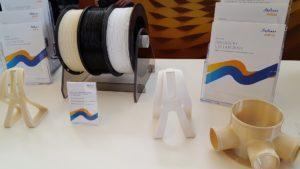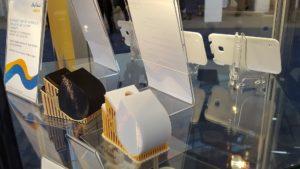Today is the last day for RAPID + TCT, and it’s been an exciting, packed week that we’ll continue to share news from even after the show closes. Some companies in particular have stood out with a number of announcements and product releases, and one of those companies is SABIC. The petrochemical manufacturer proudly showcased part of what will become the world’s first 3D printed racing yacht, printed on their BAAM 3D printer, alongside partners Autodesk and Livrea, and also unveiled a wealth of new 3D printing materials.
Eight of those materials fall into the THERMOCOMP family, which was developed specifically for large-format 3D printing. Tested on BAAM, the materials are geared towards a variety of industries including tooling, aerospace, automotive and defense.
“Delivering leading-edge solutions for large format additive manufacturing is an important part of our overall strategy to drive this technology’s growth,” said Lori Louthan, director, Mass Transportation, SABIC. “Beyond our material development expertise, SABIC has the resources to integrate processing, design and testing capabilities at our Center of Excellence for Additive Manufacturing, allowing us to help customers accelerate their application development for large printed parts.”
Each of the eight materials is based on the company’s own formulations of either ABS, PEI, PC or PPE, and is reinforced with carbon or glass fiber, depending on how much stiffness and dimensional stability is required. These eight are only the beginning, too.
“With access to more than 25 thermoplastic resins and a wide range of fillers and reinforcements, SABIC plans to expand the THERMOCOMP™ AM portfolio to address our customers’ application requirements as the adoption of this printing technology continues to grow,” noted Amanda Roble, director, Specialties Business, SABIC. “For example, we are currently developing new compounds based on semi-crystalline resins such as PBT, PA, PPS and PEEK to address the printing industry’s needs for large format materials with improved chemical resistance and stiffness.”
In addition, SABIC has developed six new FDM 3D printing filaments specifically for use with Stratasys‘ Fortus 3D printers. These include:
- ULTEM AM9085F, a high-performance PEI material with high heat resistance and mechanical strength, available in black and natural. It is UL94 V-0 compliant at 1.5 and 3.0 mm, and meets FAR 25.853 and OSU 65/65 requirements with low FST evolution.
- CYCOLAC AMMG94F, a general purpose ABS material suitable for a wide variety of applications, available in black, white and natural. It is UL94 HB compliant at 3.0 mm.
- LEXAN AM1110F, a general purpose PC filament with thermal properties higher than typical ABS filaments. It’s available in white and is UL94 V-2 compliant at 3.0 mm.
- RAPID + TCT Show [Photo by Sarah Goehrke for 3DPrint.com]
If you’re at RAPID, you can visit SABIC at Booth #2537 and check out their new materials as well as several applications 3D printed from their existing materials.
As we noted already, this week has been a big one for new material introductions, and Sculpteo has announced the general availability of Carbon’s newest resin: Flexible Polyurethane. A black, semi-rigid material with strong resistance to abrasion, fatigue and impact, FPU brings the total of Carbon materials offered by Sculpteo to five.
In addition, Sculpteo is now offering Stainless Steel 420SS/BR, 3D printed using binder jetting, as a material option. Less expensive than other metal 3D printing methods, binder jetting allows for a high level of customization. The new material is made up of 60% stainless steel and 40% bronze, and can be plated in gold or nickel. It’s a relatively delicate material, ideal for jewelry or ornamental objects. You can learn more about the new material here.“Carbon’s new FPU resin delivers parts with material qualities close to injection-molded polypropylene and it is ideal for housewares, toys, rigid packaging, living hinges, and anything that requires a lightweight and flexible plastic material,” said Sculpteo Deputy CEO Marine Core-Baillais. “Carbon has created a selection of materials that enable product designers and engineers to build functional prototypes and production parts.”
While German RepRap isn’t debuting any brand new materials this week, the company did show off their new Liquid Additive Manufacturing (LAM) technology, which they first introduced at formnext in November. The technology was developed in partnership with Dow Corning, which created a 3D printable silicone rubber material for German RepRap’s new LAM 3D printer. LAM works similarly to FDM 3D printing, with each layer cross-linked through thermal cure to create complex parts with mechanical properties similar to injection molded parts – but with complex geometries that injection molding cannot create.
“We can see a fundamental rethinking process in the minds of the entrepreneurs. More and more it is considered whether additive production can be used instead of the injection molding and milling processes,” said Floridan Bautz, Managing Director of German RepRap. “The new Liquid Additive Manufacturing (LAM) Technology is a revolution in 3D printing and will strongly influence this rethinking in a positive sense. Actually we can say it is the beginning of a new age, since there has been no comparable technology anywhere in the world.”
RAPID attendees were able to watch a demonstration of LAM 3D printing at German RepRap’s booth #623. The company also displayed a “printer farm” consisting of four x350 3D printers, all printing with different materials, in yet another example of how 3D printing is heading in the direction of serial production.
It’s been quite a race to keep up with all of the news coming out of RAPID and elsewhere this week, but we’ve enjoyed it, and we’re not nearly finished yet. Stay tuned for more as RAPID wraps up.
Share your thoughts in the Materials and Methods forum at 3DPB.com.
Subscribe to Our Email Newsletter
Stay up-to-date on all the latest news from the 3D printing industry and receive information and offers from third party vendors.
You May Also Like
3D Printing News Briefs, April 13, 2024: Robotics, Orthotics, & Hypersonics
In 3D Printing News Briefs today, we’re focusing first on robotics, as Carnegie Mellon University’s new Robotics Innovation Center will house several community outreach programs, and Ugogo3D is now working...
Rail Giant Alstom Saves $15M with 3D Printing Automation Software 3D Spark
3D Spark has entered into a three-year deal with the rail giant Alstom. Alstom, a transport behemoth with annual revenues of $16 billion, specializes in the manufacture of trains, trams,...
Meltio Expands Global Reach with New Partnerships in the Americas and Europe
Spanish 3D printing manufacturer Meltio has expanded its sales network across the globe. With the addition of three new partners in the United States, Brazil, Argentina, and Italy, Meltio aims...
3D Printing Webinar and Event Roundup: April 7, 2024
Webinars and events in the 3D printing industry are picking back up this week! Sea-Air-Space is coming to Maryland, and SAE International is sponsoring a 3D Systems webinar about 3D...




































